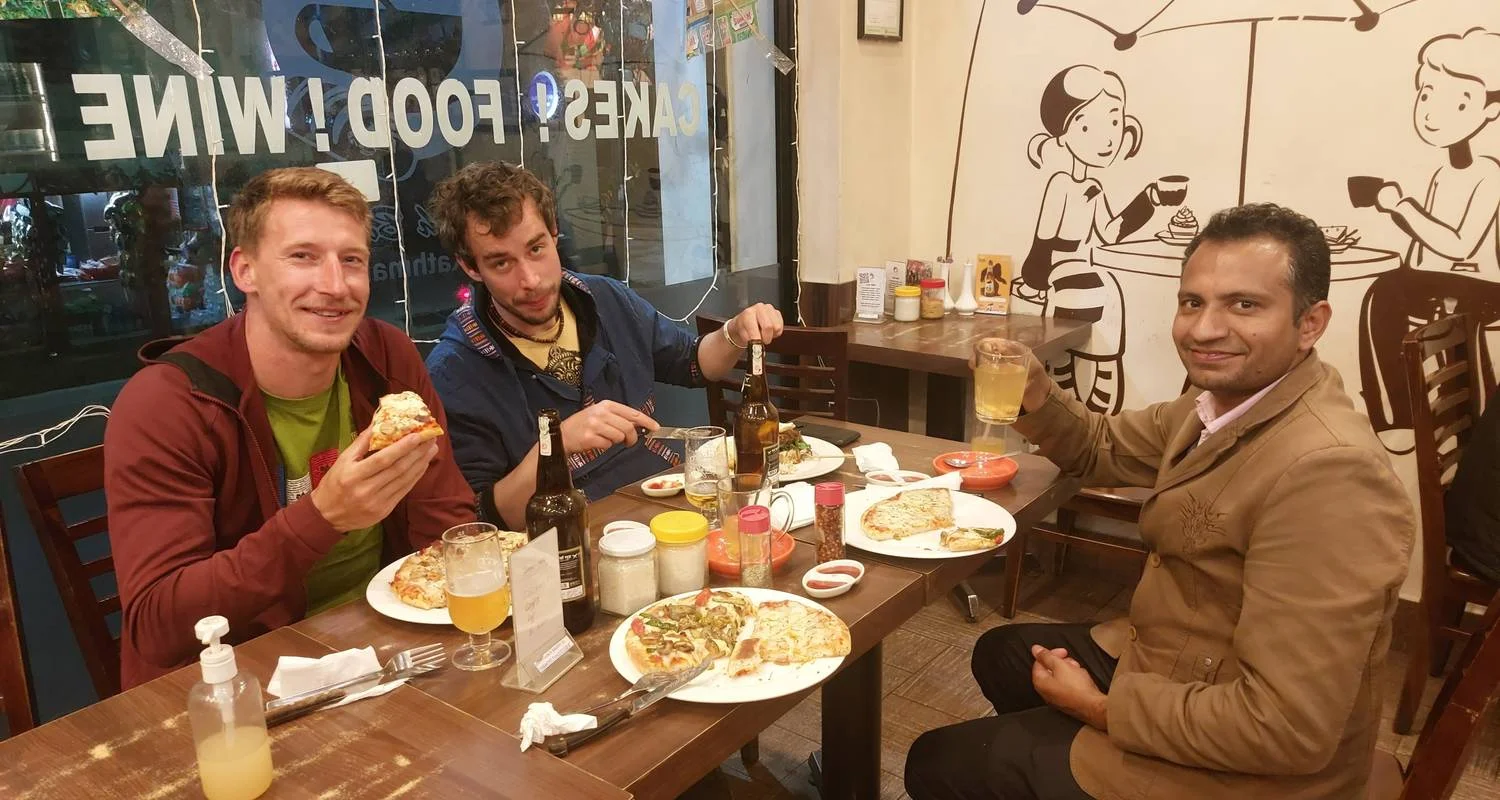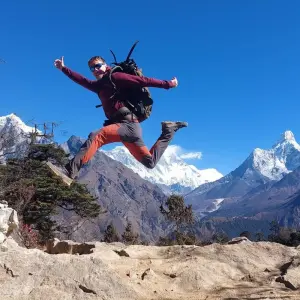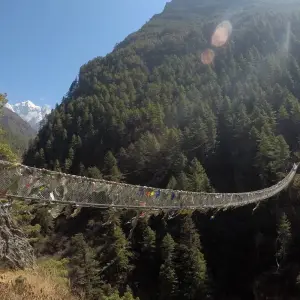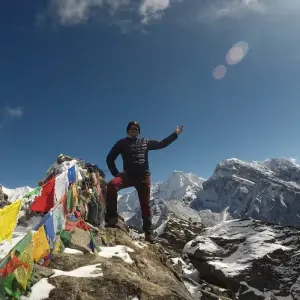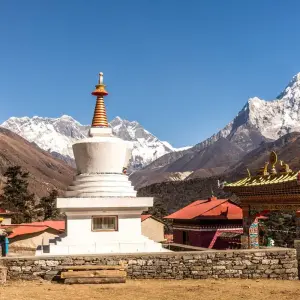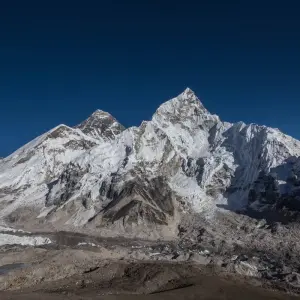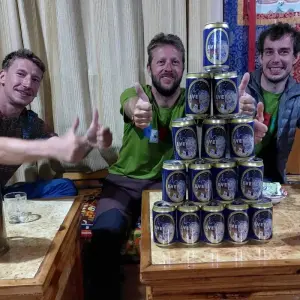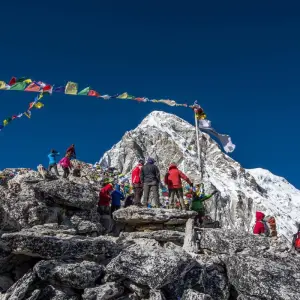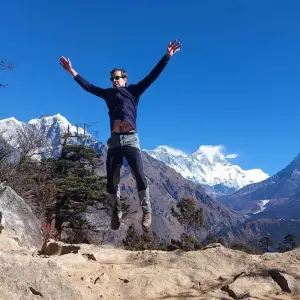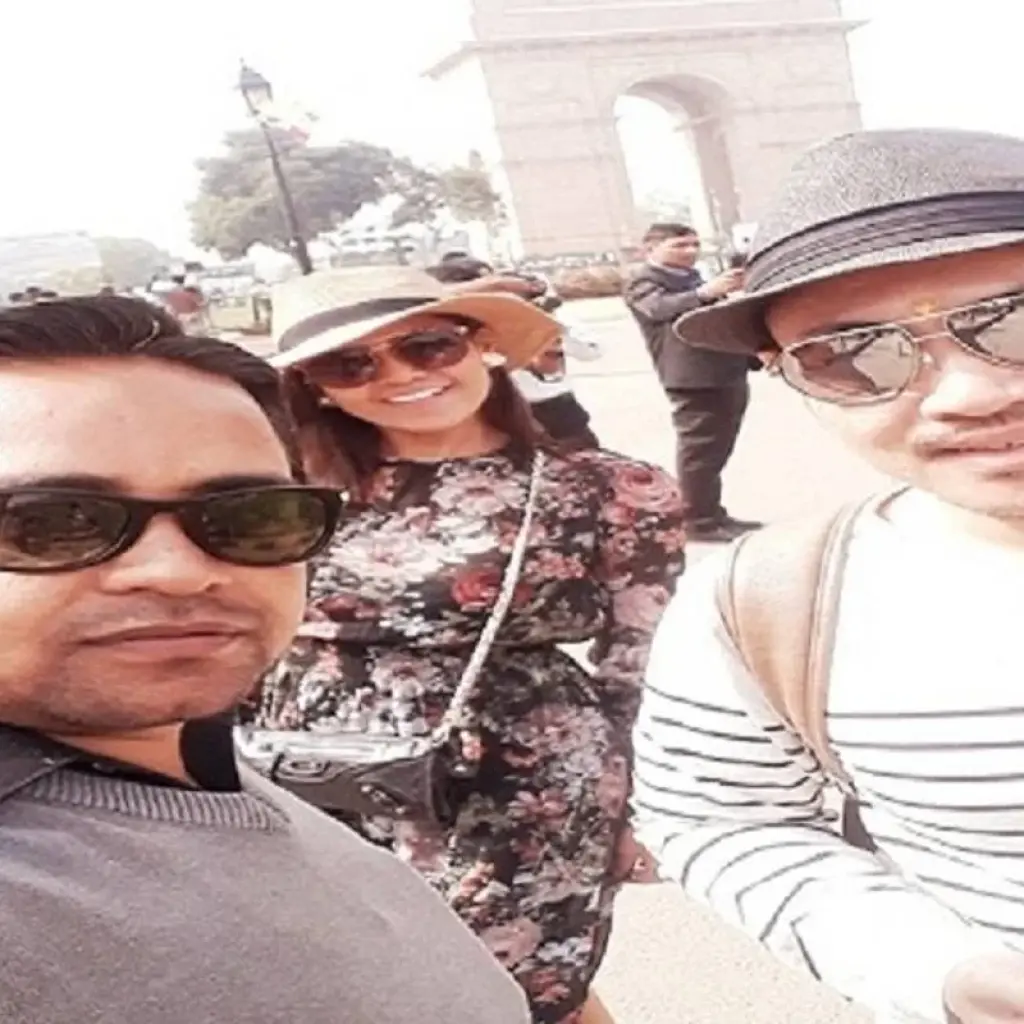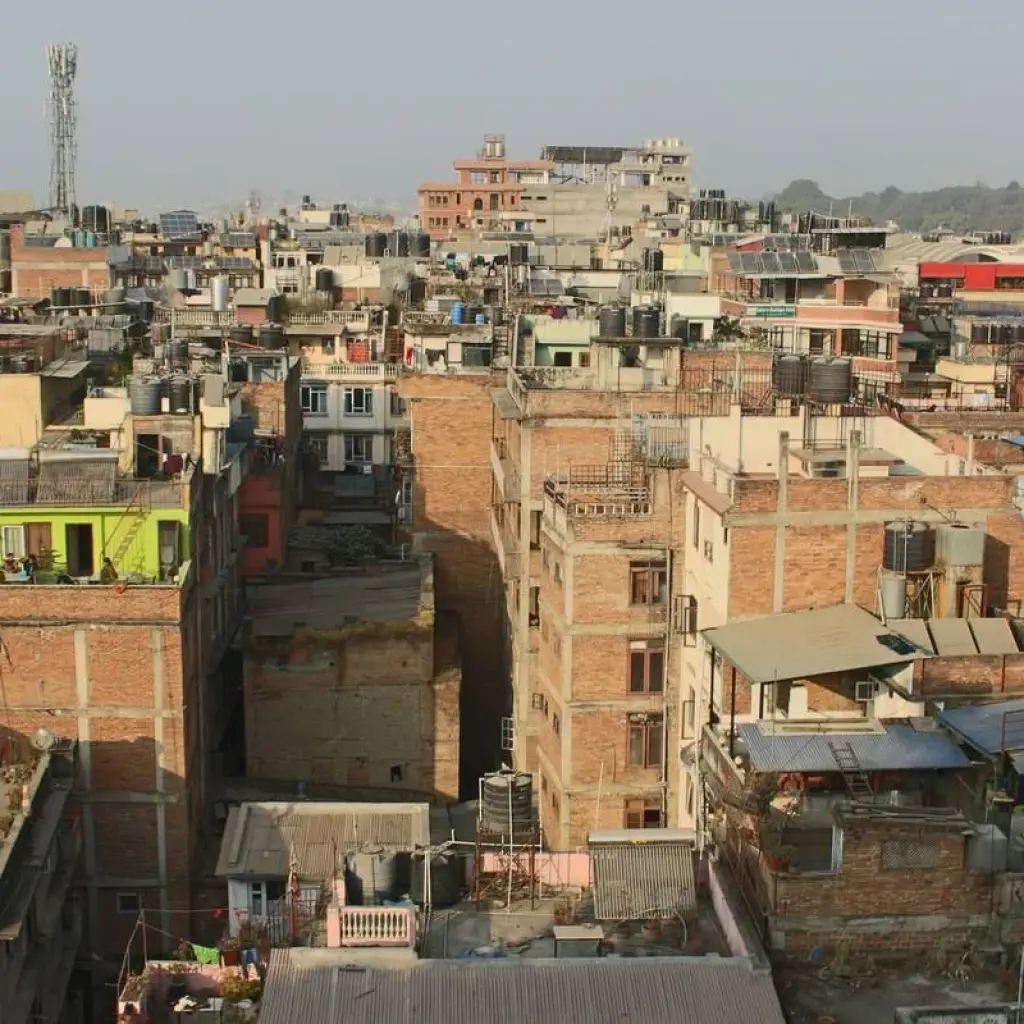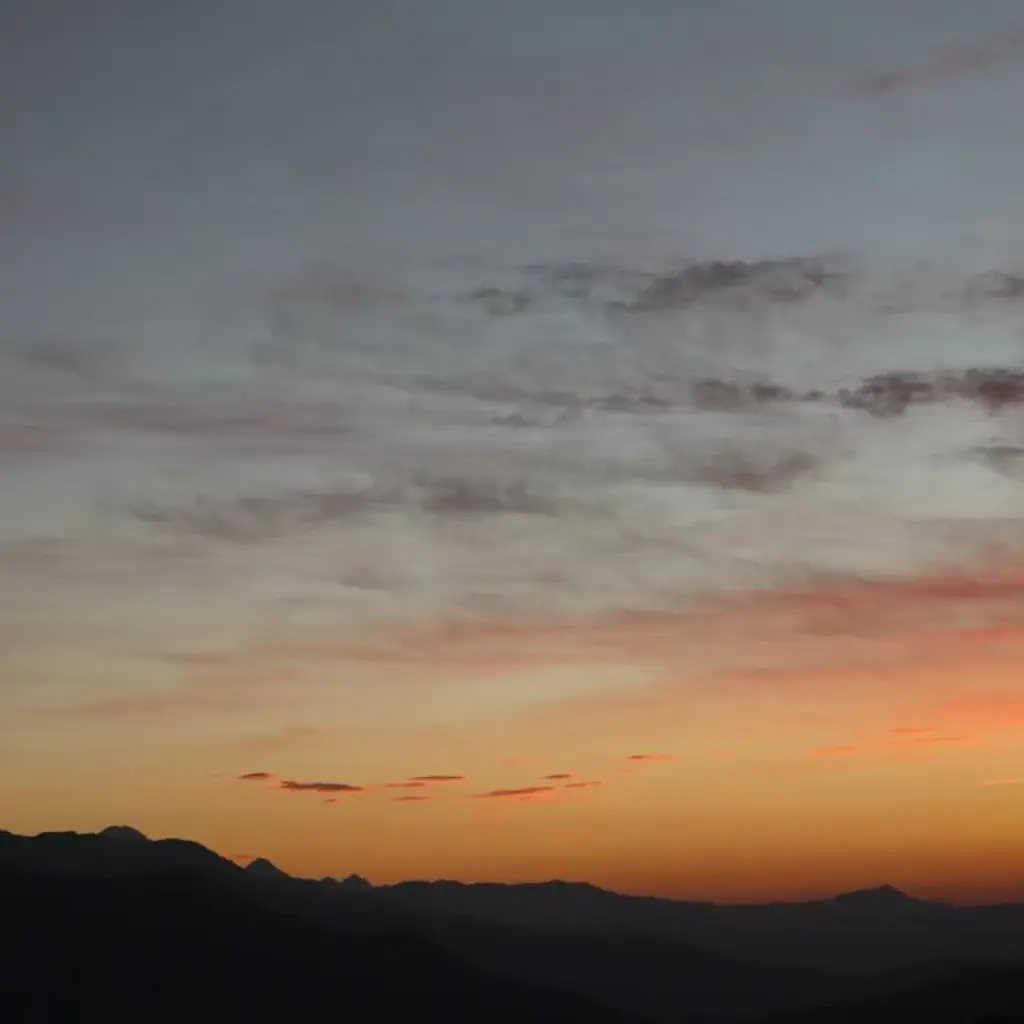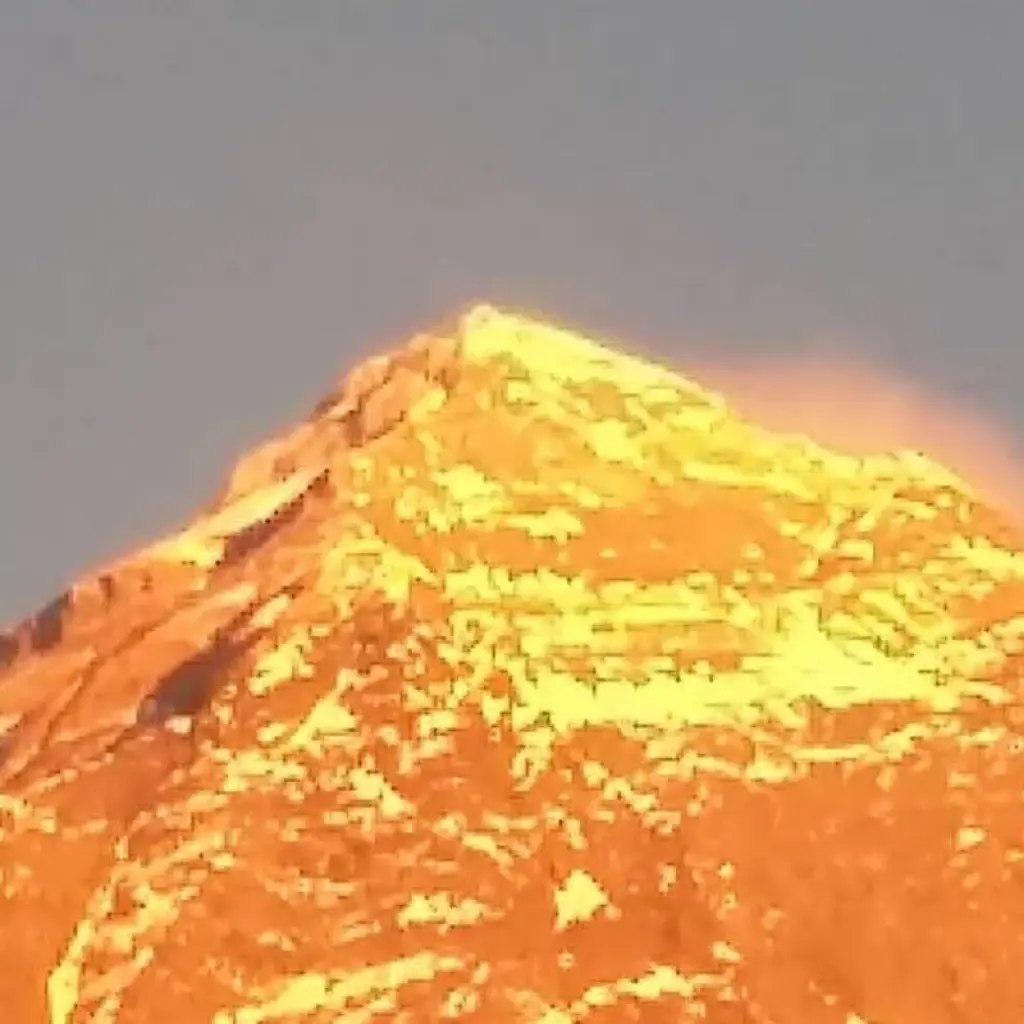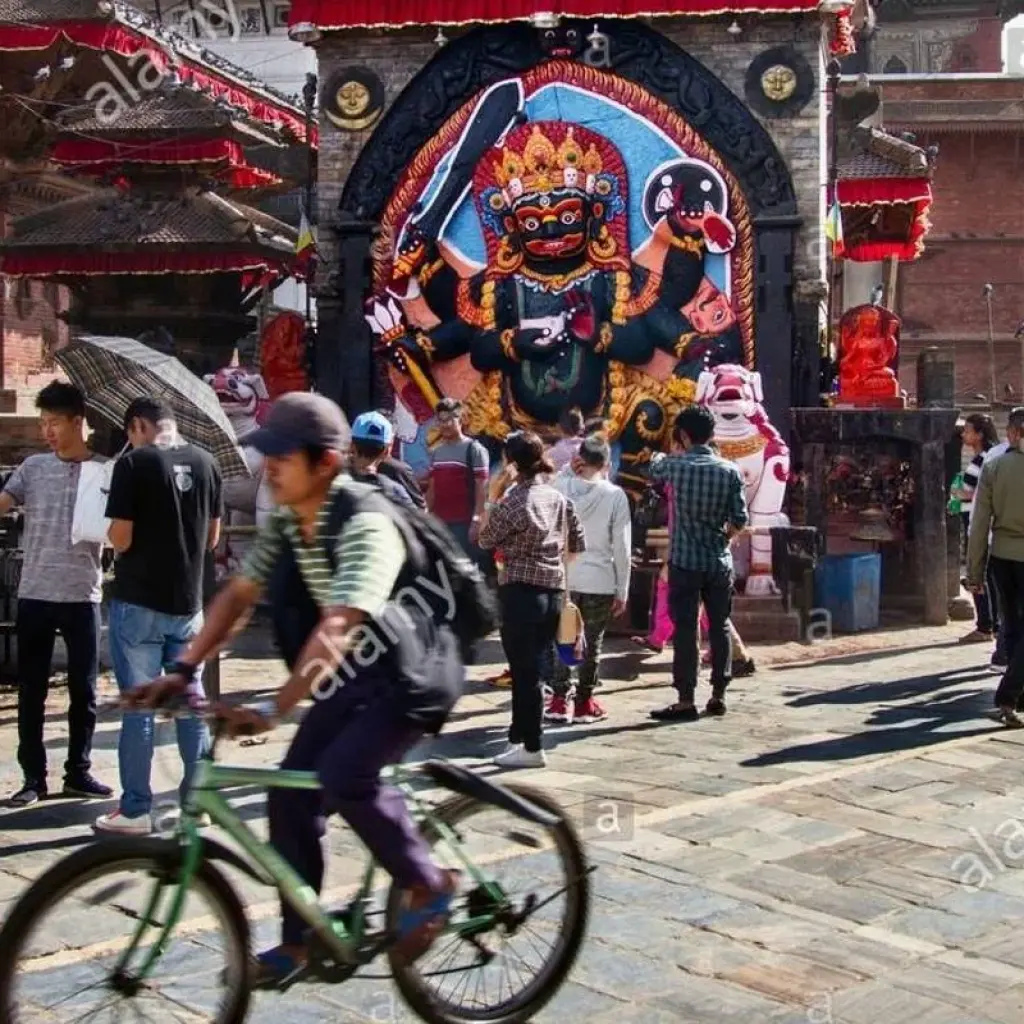Itinerary
Every single trekking enthusiast and backpacker aspires to get as far as the Everest Base Camp (5,364 m) and contemplate the snow-capped peaks in amazement. In the heartland of formidable Himalayas lies the world’s highest peak, Mt. Everest aka Sagarmatha in Nepali i.e. accompanied by other renowned summits of Mt. Lhotse (8,516m), Mt. Pumori (7,161m), Mt. Nuptse (7,855m) and many more. The desire to achieve the fantasy that embraces the prepossessing 360o outlooks of these alluring snow-capped mountain peaks attracts thousands of visitor, trekkers, and mountaineers to Khumbu region throughout the year.
The Everest base camp Kalapathar trek commences with stupendous and splendid 35 minutes flight to Lukla. From here, we advance on declining trip along the bank of Dudh Koshi river and trek through the small village of Phakding to Namche Bazaar i.e. also celebrated as “Gateway to Mt. Everest”. Actually, from this point onwards, there are many routes to reach the Everest Base Camp (5,364 m). These renowned routes are Kalapathar, Gokyo, Jiri, and Renjo pass trails. These routes are equally audacious and carry their own significant importance. On our case, we now trek to the village of Tengboche (3,870m) that showcases a spectacular monastery with the noteworthy outlook of Mt. Everest (8,848m), Mt. Ama Dablam (6,812m) and so forth. Afterward, we trek to Dingboche where we’ll have a day for resting and acclimatization purposes. In addition, we can enjoy the beautiful mountain outlooks. We resume our trek to Lobuche; then advance to Gorak Shep (5,170m) the next day. From here, we trek towards the Everest Base Camp. The Base Camp renders the alluring vistas that include the snowy peaks of Nuptse, Khumbuste, and Pumori. Eventually, we arrive at Kalapathar, the world-famous viewpoint that bestows awe-inspiring panoramas adorned with snow-covered summits of Everest, Pumori, Lingtren, Khumbetse, Nuptse, Lhotse, Ama Dablam, Thamserku parallel with many other mountaintops. Subsequently, trek to Pheriche then back to Namche Bazaar and conclude our escapade at Lukla.
Keeping the bewitching vistas aside, we also get to interact with native Sherpa communities and experience their lifestyle, culture, traditions, and hospitality throughout the whole expedition. Buddhism influenced prayer flags, Chortens, mani walls and gompas render an essence of spirituality deep inside as you spend more time in this mesmerizing land of Sherpas.
Tour program
Arrivée à Katmandou (1350m) : Transfert à l'hôtel
Start point
Tribhuvan International Airport (KTM) त्रिभुवन विमानस्थल, त्रिभुवन विमानस्थल, Kathmandu, Bagmati, Nepal
Vol matinal vers Lukla (2 840 m) et trekking vers Phakding (2 610 m) 30 minutes de vol, 5-6 heures de trekking.
Early in the morning, we’ll take a pre-scheduled flight to Lukla. This spectacular flight lasts about 30 minutes progressing above the snow-capped peaks of the Himalayan Range. Breathtaking aerial vistas can be observed from the Plane. As soon as the flight lands, we’ll commence our trekking journey on the trail, which advances beyond the scenic terrain to the Sherpa village of Chheplung (nearly 30 minutes below Lukla). The trail continues across a side valley beneath Kusum Kanguru, a trekking peak soaring 6,369m asl. Accompanied by this splendid sight, the trekking trail then passes through Ghat (2,550m), a village famed for the cluster of boulders inscribed with the Buddhist mantra: Om Mani Padme Hum for over a hundred times. At the end of the day, we arrive at Phakding (2,610m).
Nowadays, you must travel to Ramechhap during peak seasons (Oct to Nov) and (March to April). start from Kathmandu to Ramechhap at 1:00 am and reach about 6:00 am and flight to Lukla for 15 minutes and the same way back to Kathmandu after the trip over.
De Phakding à Namche bazaar (3 340 m) 5-6 heures de marche
Today, we tighten our shoe laces up and proceed on the trail along the western bank of Dudh Koshi to Benkar (2,700m). This particular village features hot springs contained in a shed and a neat waterfall. Afterwards, the trail traverses to the eastern bank of Dudh Koshi River and make its way through woodland of rhododendron and Blue pine to Chumoa and Mondzo, situated on the edge of Sagarmatha National Park. Here, we are required to show our permit or obtain one if we don’t have any. We’ll now advance to Monjo village (2,800m) and pursue an abrupt trail that abruptly descends across Monjo Khola. Afterwards, the trail drops to Jhorsalle (2,804m) after navigating past the Dudh Koshi River again. Eventually, we arrive at the conflux of Dudh Koshi and Bhote Koshi Rivers. From here, we’ll make a precipitous climb to a suspension bridge across Dudh Koshi River. Subsequent to a brief steady ascent through the forest, we reach Namche Bazaar (3,340m) that extends alluring mountain vistas.
Journée d'acclimatation à Namche Bazaar (3 340 m)
Well renowned as the Sherpa ‘capital’ and administrative centre of the Khumbu region; Namche Bazaar is home to an army camp and the headquarters of Sagarmatha National Park. It is a market town that hosts weekly market every Saturday morning where traders from other places put their goods for sale. Note that this market operates till mid-day. Furthermore, Namche flaunts internet cafes, an ATM, a bank, a German bakery, Medical and Tibetan souvenir shops alongside dozen of shops. Namche is an excellent place to acclimatize as it boasts numerous trails to surrounding villages and vintage points to aid in accommodate in higher elevations with low oxygen levels. On top of that, this very Sherpa village presents the delightful panorama of gigantic peaks including Everest, Lhotse, Nuptse, Ama Dablam, and Taweche in a clear day. You can also get familiar with ethnic Sherpa customs and traditions succeeding a tour of Village.
Trekking jusqu'à Tengboche (3 870 m) 5-6 heures de marche
This very day, we’ll trek on the trail, which initially advances through the Khumjung region then progress to prime route to Everest Base Camp at Shanasa. Afterwards, the trail makes headway to Trashinga then Phunkitenga (3,250m) where it traverses the Dudh Koshi River. Phunkitenga harbours an army checkpoint that examines trekker’s permit. Further, a broad and vertical climb uphill across the woodland composed of Juniper, Fir, Pine and Rhododendron leads to Tengboche (3,870m). The village flaunts the vistas encompassing peaks like Everest, Ama Dablam, Kantega etc. Moreover, it harbours Tengboche Monastery aka Dawa Choling Gompa, the largest of its kind in Khumbu region. Tengboche also functions as a lookout point displaying sublime sunset vista over Mt. Everest and Mt. Ama Dablam.
Jour 6 : Tengboche / Dingboche
Jour 7 : Journée libre à Dingboche
The day seven of our adventure is allocated for the second acclimatization. As the elevation keeps on increasing, we are required to get adapt with the surrounding in order to avoid difficulties like Acute Mountain Sickness (AMS). If sitting ideal does not match your preference, you can hike in the magnificent Chhukung Valley. Also, you can trek to Nangkartshang Hill (5,090m), which showcases admirable vistas of Ama Dablam, Lhotse, Island peak, Makalu and incredible view of the valley. This trek utilizes about 4-5 hours. But we strongly urge you to provide acclimatizing time to your body so that it can prepare itself for upcoming arduous journey.
De Dingboche à Lobuche (4 960 m) : 5/6 heures
Accompanied by majestic outlook of Tawache and Cholatse peaks; today, we ascend on a ridge. Thereupon, we advance beyond the pasturelands and walk across a wooden bridge to Dughla (4,620m). From here, the trail ascends precipitously to the crest of a glacial moraine then continues past the memorial dedicated to the fallen climbers and Sherpa during numerous Everest expeditions. We also get to observe the astonishing sight encompassing Lingtren (6,697), Pumori (7,145 m), Lingtren (6,697), and Mahalangur Himal. You are deprived of the Everest view here as the world’s highest mountain is concealed behind the lofty wall of Lhotse and Nuptse. After a short hike, we’ll reach Lobuche (4,960m)
De Lobuche à Gorakshep (5 170 m) : 4/5 heures
Visit Everest Base Camp (5,364m) From Lobuche, we’ll begin our trek on rock-strewn trail through the Khumbu Glacier to set foot in Gorak shep (5,170m). We’ll then make our climb to Everest Base Camp (EBC). The Base camp is a wonderful place where you can reach via trekking only (without use of mountaineering equipment). Here, you can get a sight of colourful camps set up by the mountaineers during their Everest expedition. Don’t expect a warm welcome from the climbers there, respect their privacy and concentrate to fulfil your Everest dream i.e. sightseeing and snapping pictures. You may be disappointed as you don’t observe the full picture of colossal Mt. Everest from bottom to top as expected because you are too near to the mountain itself. But, you can contemplate striking Khumbu Icefall. On top of that, you can also get the awe-inspiring glimpses of snowy mountaintops including Pumori, Mahalangur, Lingtern, Khumbutse, Nuptse, and many more. In the end, we’ll return back to Gorak Shep (5,170m).
Gorakshep à Kala Patther (5 545 m) et Pheriche (4 288 m) : 6/7 heures
Today, early in the morning, we will make our way to Kalapatthar. At the elevation of 5,545m; Kalapatthar is the highest point of our trek and also widely celebrated viewpoint in the Khumbu region, located further and at a higher elevation than Everest Base Camp. Therefore, this viewpoint tends to turn your Everest dream into reality by showcasing the full view of the world’s highest peak in close proximity. This spot also flaunts sight of the mesmerizing sunrise above the Mt. Everest aka Chomolungma or Mother Goddess of the Universe in Tibetan and Sagarmatha in Nepali respectively. Furthermore, it is the ultimate location to enjoy the panoramic outlook encompassing snow-capped mountaintops of Everest, Ama Dablam, Lhotse, Nuptse, Pumori, Lingtren, Khumbutse, Changtse, and many more. Else, just above the Lho La pass, we can discover the colossal face of Changtse (7,750m). Since there are no accommodation facilities available here; we’ll trek back to Pheriche (4,288m).
De Pheriche à Namche Bazaar (3 340 m) : 6/7 heures
On the break of the dawn, we pursue the trail, which progresses back to Pangboche through the green woodlands. Subsequently, the trail advances across Tengboche. En route, we’ll probably confront exquisite Himalayan wildlife, Himalayan Tahr, Pheasants, Musk deer and much more. The trail now descends along the Dudh Koshi River to Phunki Tenga then ascends to Khumjung region past Sanasa Village. Eventually, the trail leads the way to Namche Bazaar (3,340m).
De Namche Bazaar à Lukla (2 840 m) : 6/7 heures
The trail makes a downhill descent beyond the suspension bridges to the village of Monjo. Following the progress across the villages of Chumoa and Mondzo; the trail passes to the other side of rhododendron and fir woodland. Complemented by lush greenery with snowy mountaintops as the backdrop; the trail now traverses suspension bridges, numerous Sherpa settlements. Without any obstacles to break off, the trail finally reaches the village of Phakding (2,610m). From this point onwards, the trail ultimately ends up at Lukla (2,840m).
Lukla - Katmandou : 35 min de vol/ Lukla - Ramechhap : vol en avion et retour en voiture à Katmandou.
Today, you’ll head to Kathmandu from Lukla via a scenic flight that will take about 30 minutes. The flight delivers the lovely aerial outlooks comprising snow-capped mountains of the formidable Himalayan Range.
Nowadays, you must travel to Ramechhap during peak seasons (Oct to Nov) and (March to April). start from Kathmandu to Ramechhap at 1:00 am and reach about 6:00 am and flight to Lukla for 15 minutes and the same way back to Kathmandu after the trip over.
Départ
Today is the last day of your escapade in Nepal. Following farewells, one of our representatives will guide you to the Kathmandu Airport, 3 hours before your flight’s actual time of departure. We wish you a safe flight back home!!
End point
Kathmandu, Bagmati, Nepal
Tour Details
accommodation
- 2 nuits dans un hôtel de luxe à Katmandou avec petit-déjeuner
- Tous les hébergements dans la montagne selon l'itinéraire
flights
- Katmandou - Lukla par vol/temps de saison de Ramechhap à Lukla
- Vol Lukla - Katmandou après le voyage/Lukla - Ramechhap (aller-retour)
guide
- Guide professionnel parlant anglais et son salaire, nourriture, assurance, vol et hébergement.
meals
- Dîner de bienvenue à Katmandou avant le voyage
- Le petit-déjeuner est inclus à Katmandou
- Pendant vos randonnées, des repas complets sont inclus.
- Dîner d'adieu après le voyage
optional
- Si vous souhaitez prendre un hélicoptère de Gorakshep à Lukla, il vous en coûtera 1900 USD pour 2 personnes.
Meilleure saison pour le trek du camp de base de l'Everest
Himalayan Trekking Path vous offre la possibilité d'entreprendre le trek du camp de base de l'Everest à tout moment de l'année. Chaque saison offre ses propres expériences, et nous pouvons vous fournir des informations complètes sur les saisons et leurs points forts. Il vous suffit de nous indiquer votre période préférée et nous serons heureux de vous aider à réaliser le voyage de vos rêves.
Saison d'automne : De septembre à novembre
L'automne est la saison idéale pour entreprendre le trek du camp de base de l'Everest, tout comme dans les autres régions du Népal. Pendant cette saison, les précipitations diminuent, laissant place à des journées ensoleillées qui font ressortir la verdure éclatante à basse altitude et le ciel clair au-dessus. Le climat est généralement agréable, avec des températures chaudes et des conditions météorologiques stables. Cette période offre une excellente occasion d'admirer les chaînes himalayennes à couper le souffle et de s'immerger dans la beauté des vallées verdoyantes. En général, à cette époque de l'année, les maisons de thé sont souvent complètes en raison du grand nombre de touristes sur la piste. Il peut arriver que vous soyez confronté à des embouteillages le long de la route. Si vous envisagez d'entreprendre le trek de l'Everest, il est conseillé de faire vos réservations à l'avance afin de vous assurer un hébergement dans les maisons de thé situées le long du sentier.
Saison de printemps : De mars à mai
Le printemps, la deuxième saison de trekking la plus appréciée au Népal après l'automne, offre des vues époustouflantes de paysages en fleurs et de verdure luxuriante le long de l'itinéraire du trek du camp de base de l'Everest, à basse altitude. Le voyage est agrémenté de panoramas pittoresques de l'Himalaya en toile de fond. Pendant cette saison, les jours sont plus longs et le temps reste stable. Même au camp de base, la température est relativement douce. Si vous préférez voyager par des températures agréables et des journées plus longues, réservez votre voyage pour cette saison.
Saison d'hiver : De décembre à février
Si vous recherchez la tranquillité, le trek du camp de base de l'Everest est parfait pendant l'hiver. Il est recommandé d'entreprendre ce trek entre décembre et février pour une expérience sereine. Si le temps est clément, vous pouvez vous attendre à une expérience similaire à celle de la haute saison. L'hiver étant considéré comme la basse saison au Népal, vous bénéficierez d'un excellent traitement partout où vous irez. Toutefois, il est important de noter que la pluie, les chutes de neige, les nuages, les tempêtes et les annulations de vols sont fréquents durant cette période. Nous vous invitons à vous joindre à nous pour un trek hivernal si vous disposez de suffisamment de temps et de l'équipement adéquat.
La mousson : De juin à août
Le trek du camp de base de l'Everest pendant la mousson peut être assez difficile. Le ciel nuageux entraîne souvent l'annulation des vols entre Katmandou et Lukla, ce qui rend difficile l'accès au départ du sentier. En outre, le sentier lui-même devient glissant et humide, ce qui ajoute à l'inconfort général. L'expérience dépend fortement des conditions météorologiques ; si le temps est favorable, vous pouvez vous attendre à un voyage gratifiant. En revanche, si le temps se gâte, vous risquez d'être déçu par les vues limitées et les retards de vol potentiels. Néanmoins, si vous disposez de suffisamment de temps et de l'équipement adéquat, nous sommes là pour vous accompagner tout au long du trek.
Assurance voyage pour le trek du camp de base de l'Everest
Notre principale préoccupation est votre sécurité, car nous sommes entièrement dévoués à vous offrir une expérience exceptionnelle tout au long de votre expédition au camp de base de l'Everest. Il est obligatoire de souscrire une assurance voyage pour ce voyage aventureux au Népal, et nous vous le recommandons vivement pour votre sécurité. Nous recommandons vivement à tous les trekkeurs de souscrire une assurance voyage appropriée qui couvre le sauvetage, le vol et les urgences médicales.
Comment se préparer à combattre le mal aigu des montagnes ?
- Veillez à une bonne hydratation en consommant environ 3 à 4 litres d'eau par jour.
- Marchez tranquillement et n'oubliez pas de faire des pauses régulières toutes les 30 minutes pendant votre randonnée
- Il est important de respecter les instructions de votre guide et de suivre l'itinéraire prévu.
- Évitez de vous précipiter et de vous inquiéter inutilement pendant votre voyage.
- Consommez suffisamment de nourriture pour refaire le plein d'énergie.
- Profitez de la beauté de la nature et des paysages environnants.
- S'abstenir de consommer de l'alcool et de fumer à des altitudes supérieures à 4 000 m est essentiel pour rester en bonne santé et prévenir le mal des montagnes.
Liste des bagages pour le trek du camp de base de l'Everest
- Matériel essentiel : Préparez un sac à dos ou un sac de jour (40L) selon que vous utiliserez ou non un porteur.. N'oubliez pas d'emporter une bouteille d'eau de 2 à 3 litres, des bâtons de trekking, une méthode de purification de l'eau et un sac de couchage avec une doublure (envisagez une capacité de -20 degrés pour les randonnées hivernales).
- Couvre-chef : Pour vous protéger du soleil, vous avez le choix entre un chapeau ou un foulard. Dans les climats plus froids, il est recommandé de porter un chapeau d'hiver ou un chapeau à bords arrondis conçu pour vous protéger des éléments hivernaux. En outre, il est toujours judicieux d'emporter une lampe frontale avec des piles de rechange afin de disposer d'un éclairage adéquat dans toutes les situations.
- Protections faciales : Lorsqu'il s'agit de protéger votre peau, n'oubliez pas d'inclure dans votre routine quotidienne de la crème solaire, des lunettes de soleil avec protection UV et des lingettes pour le visage et le corps. Ces articles jouent un rôle essentiel en protégeant votre peau des rayons UV nocifs et en la gardant propre et fraîche.
- Vêtements de main : Les gants légers offrent confort et souplesse, tandis que les gants d'hiver épais assurent une isolation supérieure dans des conditions de froid extrême.
- Exigences corporelles : Pour une expérience de randonnée réussie, il est important d'avoir les vêtements appropriés. Il peut s'agir de chemises de randonnée en fibres synthétiques, de chemises à manches longues, d'une veste de pluie à capuche, d'une veste polaire, de pantalons légers en coton, de sous-vêtements en polypropylène, d'une doudoune pour les randonnées hivernales, de vestes et de pantalons imperméables.
- Chaussures : Les options de chaussures comprennent des chaussures de randonnée imperméables, des chaussettes en laine épaisse et des chaussures de sport ou des sandales pour se détendre pendant les périodes de repos.
- Articles de toilette : Lorsque vous partez en randonnée, assurez-vous d'emporter une serviette à séchage rapide, une brosse à dents, du dentifrice, du papier hygiénique, du savon, du gel douche, de la lessive en poudre, un coupe-ongles et un miroir compact.
- Protection contre la pluie : Lorsque vous vous préparez à la pluie, il est important de ne pas oublier d'emporter un coupe-vent en plus d'une protection contre la pluie. Cela comprend des vestes de pluie ou des ponchos et des housses de sac, ainsi que des crampons pour les pistes glacées et glissantes.
Combien d'argent népalais faut-il pour le Trek for Additional Service ?
transport
- Tous les transports en véhicule privé
- Le vol Katmandou-Lukla ou Ramechhap-Lukla
- Vol en avion de Lukla à Katmandou ou de Lukla à Ramechhap
- De Katmandou à Ramechhap en Jeep
- De Ramechhap à Katmandou en jeep
Good to know
Currency
Nepalese Rupee
Népal

